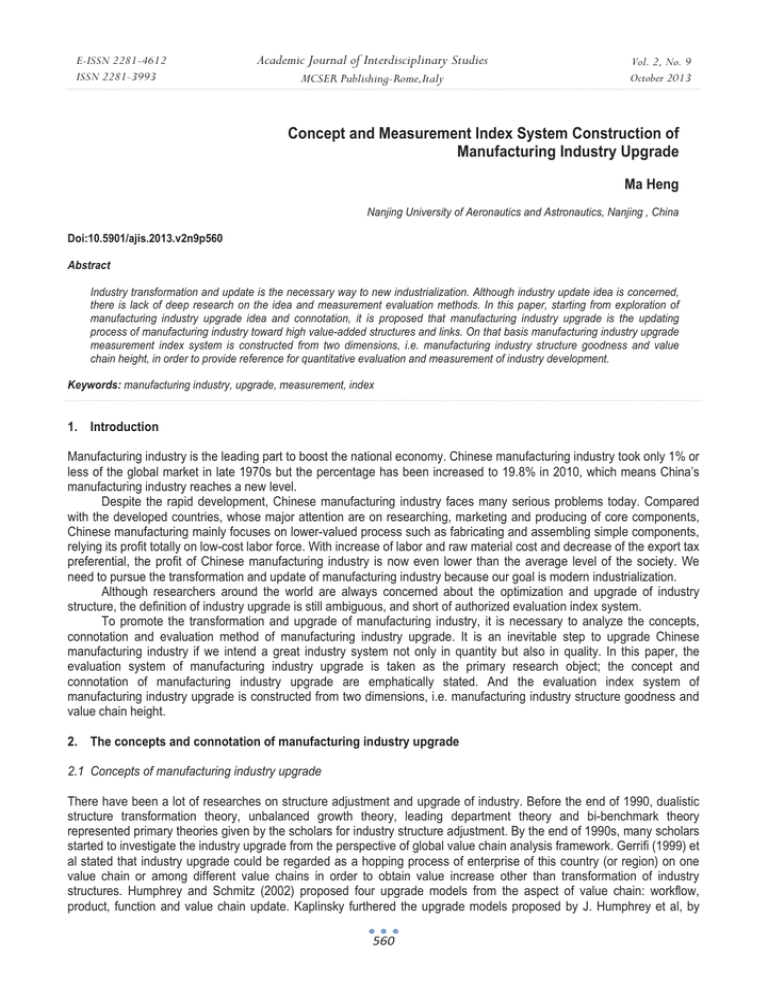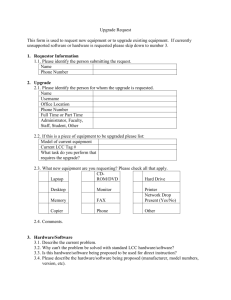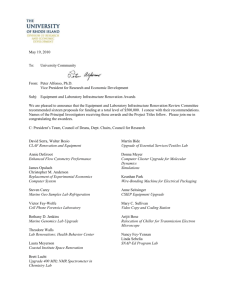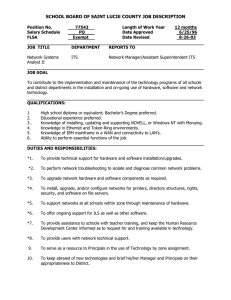Concept and Measurement Index System Construction of Manufacturing Industry Upgrade Ma Heng
advertisement

E-ISSN 2281-4612 ISSN 2281-3993 Academic Journal of Interdisciplinary Studies MCSER Publishing-Rome,Italy Vol. 2, No. 9 October 2013 Concept and Measurement Index System Construction of Manufacturing Industry Upgrade Ma Heng Nanjing University of Aeronautics and Astronautics, Nanjing , China Doi:10.5901/ajis.2013.v2n9p560 Abstract Industry transformation and update is the necessary way to new industrialization. Although industry update idea is concerned, there is lack of deep research on the idea and measurement evaluation methods. In this paper, starting from exploration of manufacturing industry upgrade idea and connotation, it is proposed that manufacturing industry upgrade is the updating process of manufacturing industry toward high value-added structures and links. On that basis manufacturing industry upgrade measurement index system is constructed from two dimensions, i.e. manufacturing industry structure goodness and value chain height, in order to provide reference for quantitative evaluation and measurement of industry development. Keywords: manufacturing industry, upgrade, measurement, index 1. Introduction Manufacturing industry is the leading part to boost the national economy. Chinese manufacturing industry took only 1% or less of the global market in late 1970s but the percentage has been increased to 19.8% in 2010, which means China’s manufacturing industry reaches a new level. Despite the rapid development, Chinese manufacturing industry faces many serious problems today. Compared with the developed countries, whose major attention are on researching, marketing and producing of core components, Chinese manufacturing mainly focuses on lower-valued process such as fabricating and assembling simple components, relying its profit totally on low-cost labor force. With increase of labor and raw material cost and decrease of the export tax preferential, the profit of Chinese manufacturing industry is now even lower than the average level of the society. We need to pursue the transformation and update of manufacturing industry because our goal is modern industrialization. Although researchers around the world are always concerned about the optimization and upgrade of industry structure, the definition of industry upgrade is still ambiguous, and short of authorized evaluation index system. To promote the transformation and upgrade of manufacturing industry, it is necessary to analyze the concepts, connotation and evaluation method of manufacturing industry upgrade. It is an inevitable step to upgrade Chinese manufacturing industry if we intend a great industry system not only in quantity but also in quality. In this paper, the evaluation system of manufacturing industry upgrade is taken as the primary research object; the concept and connotation of manufacturing industry upgrade are emphatically stated. And the evaluation index system of manufacturing industry upgrade is constructed from two dimensions, i.e. manufacturing industry structure goodness and value chain height. 2. The concepts and connotation of manufacturing industry upgrade 2.1 Concepts of manufacturing industry upgrade There have been a lot of researches on structure adjustment and upgrade of industry. Before the end of 1990, dualistic structure transformation theory, unbalanced growth theory, leading department theory and bi-benchmark theory represented primary theories given by the scholars for industry structure adjustment. By the end of 1990s, many scholars started to investigate the industry upgrade from the perspective of global value chain analysis framework. Gerrifi (1999) et al stated that industry upgrade could be regarded as a hopping process of enterprise of this country (or region) on one value chain or among different value chains in order to obtain value increase other than transformation of industry structures. Humphrey and Schmitz (2002) proposed four upgrade models from the aspect of value chain: workflow, product, function and value chain update. Kaplinsky furthered the upgrade models proposed by J. Humphrey et al, by 560 E-ISSN 2281-4612 ISSN 2281-3993 Academic Journal of Interdisciplinary Studies MCSER Publishing-Rome,Italy Vol. 2, No. 9 October 2013 pointing out that the upgrade among different value chains is equivalent to that among distinct industries, i.e. the adjustment of industry structure. Poon (2004) assumed that industry upgrade was a transfer process conducted by manufacturers from producing labor-intensive and low-valued products to technology-intensive and higher-valued products. From argument above we could see that scholars around the world share similar opinions on understanding ‘industry upgrade’, which is industry evolution on value chains from low technological and valued level to high level. Since the Reform and Opening up, industry structure gradually became a hot topic among economists. Chongbo Wu claimed that industry upgrade was evolution of industry structure. He considered it as the adjustment of industry structure. Ru Zhe (2006), Xueqing Jing (2008), Ping Li (2010) also thought industry upgrade was equivalent to the upgrade of industry structure. In recent years, researchers in China studied the industry upgrade through value chains. Yaohui Zhang proposed that the true meaning of industry upgrade was the process in which high-valued industry replaced the low-valued one and industrial innovation was the main content of industry upgrade. Bin Tang (2005) stated that manufacturing industry structure changed from labor-intensive mode to capital-intensive model, then to technologyintensive mode, which means it transferred from low-valued industry to a high-valued one. From the aspect of global value chains, Xia Gong (2011) analyzed the reason why the process of upgrade in labor-intensive manufacturing industry was so slow. From the argument above, we could see that we do not have a unified understanding of industry upgrade. The concept of industry upgrade is not yet uniform. Since the most common form of labor division today is based on global value chains, it is especially important that we clarify the concept and connotation of industry upgrade. Besides, although existing statements have partially characterized some basic features of future industry, such as technology-intensive and high-valued, they failed to elucidate goals and directions of industry upgrade. The measurement of industry is surely a tough problem we are desperate to solve. Qi Liang et al simply define industry upgrade as a transfer from labor-intensive mode to capital-intensive mode. They tried to use this concept to measure the industry upgrade of Yangtze River Delta but were criticized as over simplified. This is resulted from the fact that our concepts are short of description of measureable characters of industry upgrade and could hardly satisfy the measurement of industry upgrade. In this paper we will introduce ideas in econometrics and propose the concept of manufacturing industry upgrade. Industry upgrade is a process in which manufacturing industry transforms to a high-valued level or high-valued process. It has two dimensions. One is the goodness of structure. The larger the percentage of high-valued manufacturing industry, the better the structure goodness is. The other is the level of value chains. The larger the percentage of high-valued processes the higher the level of value chains is. The destination of manufacturing industry upgrade is to transform to a high-valued level and high-valued process, and improve value and profit of manufacturing industry. 2.2 The connotation of manufacturing industry upgrade 2.2.1 Optimization of manufacturing industry structure The optimization of manufacturing industry structure is a process that economic body transfers from low-valued position to high-valued position on value chain. This transformation of industry structure from low level to high level not only presents in the structure transform through three industries but also in the change of inner structure of manufacturing industry, as shown in Fig.1. Fig.1. Illustration of industry structure optimization The basic development trend of manufacturing industry is that the development of labor-intensive manufacturing industry requires better condition of heavy industry thus it promotes the development of by-products and capital industry. The 561 E-ISSN 2281-4612 ISSN 2281-3993 Academic Journal of Interdisciplinary Studies MCSER Publishing-Rome,Italy Vol. 2, No. 9 October 2013 increase of market’s need pushes transformation of manufacturing structure to capital-intensive and technology-intensive industry. Manufacturing structure is changing from labor-intensive mode to capital-intensive and technology-intensive mode, which could result in the improvement of profit in manufacturing industry. It follows from the cases around the world that technology-intensive mode is still the goal of industry upgrade. 2.2.2 Value chain height increase of manufacturing industry Value chain is made up of many value rings. The value distribution of each ring is a ‘smiling curve’, as shown in Fig.2. The value of the bottom point, which represents the assembling process, is the lowest while the two upper points, one represents researching and designing processes and the other represents marketing, have the highest values. Fig.2. Simplified value chain curve Labor division mode of global value chain makes the competitive advantage of manufacturing industry to reflect not only in a product or a particular industry, but also in the labor division link of industry value chain. It will bring higher industrial added value if it is in the high-end or strategic link, inversely, it will bring lower industrial added value and return if it is in the end or common link. Manufacturing industry in our country has turned into "international manufacturing workshop" by the advantage of low-cost factor of production, it is engaged in assembly and production links which make less profit, and has formed a certain comparative advantage in low added value link of manufacturing industry chain. With the rise of other regions which have the lower cost of production factors, it is difficult to keep the advantages of manufacturing industry in our country from processing manufacture link. The manufacturing enterprises and multinational corporations who possess the brand and the core technology in developed countries take up the R&D link and the marketing link which is in the high-end of the industry value chain, and earn 90%~95% of the profit. The ARM ability of manufacturing industry in our country is very weak, the level of research and application in the critical manufacturing technology is low, most products of the companies do not possess ownbrand, are OEM, the enterprise always can only get thin profit in the end of the industry value chain. The competitive advantage of the enterprises which is at the bottom of value chain is easier to disappear. Manufacturing industry in our country must transfer from low added-value production processes of industry value chain to high added-value technical and marketing links, and achieve a rise of value chain height, sequentially improve the profitability competitive capacity of manufacturing industry in our country. 3. The construction of measurement index system of manufacturing upgrade This paper constructs manufacturing upgrade measurement index system from two dimensions, i.e. manufacturing industry structure goodness and value chain height. 3.1 Manufacturing industry structure goodness model The fundamental laws of manufacturing industry evolution are transition from labor-intensive manufacturing industry to higher value-added and capital-intensive and technology-intensive industry. From looking at the actual situation of the 562 Academic Journal of Interdisciplinary Studies E-ISSN 2281-4612 ISSN 2281-3993 Vol. 2, No. 9 October 2013 MCSER Publishing-Rome,Italy development of the manufacturing industry at home and abroad, technology-intensive industry is the update direction of manufacturing industry structure in China. Suppose three typical manufacturing industry structures are: labor-intensive at ( L ) 㸦1,0,0㸧, capital-intensive at (C ) 㸦0,1,0㸧 and technology-intensive at ( I ) 㸦0,0,1㸧. The bigger the difference between actual manufacturing industry structure and the typical one is, the lower the nearness of them is. Consequently, the nearness between actual manufacturing industry structure and the typical one is constructed based on Euclidean distance, namely (1) r = 1 − [(a ( L) − at ( L)) 2 + (a(C ) − at (C )) 2 + (a( I ) − at ( I )) 2 ]1/2 / 2 Where ( a ( L ), a (C ), a ( I )) expresses actual manufacturing industry structure, and (at ( L), at (C ), at ( I )) is typical manufacturing industry structure. a ( L ) stands for the proportion of labor-intensive industry, and its value equals to the total output value of labor-intensive industry divided by total output value of manufacturing industry. a (C ) expresses the proportion of capital-intensive industry, and can be obtained through total output value of capital-intensive industry divided by total output value of manufacturing industry. a ( I ) expresses the proportion of technology-intensive industry, and its value equals to total output value of technology-intensive industry divided by total output value of manufacturing industry. Then we have 0 ≤ a ( L ), a (C ), a ( I ) ≤ 1 and a ( L) + a (C ) + a ( I ) = 1 . Structure goodness is used to reflect the development and evolution levels of manufacturing industry structure. The manufacturing industry structure goodness model is built as following. (2) E = β1rL + β 2 rC + β 3rI where rL expresses the nearness between actual manufacturing structure and labor-intensive structure, expresses the nearness between actual manufacturing structure and capital-intensive structure, nearness between actual manufacturing structure and technology-intensive structure, goodness, and rI rC expresses the β1 , β 2 , β3 are coefficients of β1 < β 2 < β3 . The closer the actual manufacturing structure to technology-intensive structure is, the more excellent its structure is. The closer the actual manufacturing structure to labor-intensive structure is, the poorer its structure is. 3.2 Manufacturing industry value chain height composite index The value distribution rule of global value chain indicates that R&D and marketing are at the high end of the value chain. What the manufacturing industry value chain height incarnates is whether the manufacturing industry has seized hold of R&D links and marketing links or not, which are at the high end of the value chain. In fact manufacturing industry value chain height refers to innovation ability and marketing ability of industry. Consequently, manufacturing industry value chain height is evaluated from two dimensions, i.e. innovation ability and marketing ability, as presented in this paper. Based on the availability of data, we choose four indexes, i.e. intensity of R&D involvement, number of patent applied, number of patent granted, and proportion of new product sales to characterize the upstream links of the value chain, which represent the R&D ability of manufacturing industry; three indexes, i.e. number of well-known trademarks, total of valid registered trademarks, and total quantity of famous trademarks, are chosen to characterize the downstream links of the value chain, which represent the marketing ability of manufacturing industry. The greater the proportion of the manufacturing industry in the upstream links of the value chain is, the higher the manufacturing industry value chain height is. The above seven indexes are non-dimensionalized, and the effect of different dimensions is eliminated by utility X ij − Min( X ij ) . The area division of utility value is selected as method and according to the formula Vij = Max( X ij ) − Min( X ij ) [0,100]. In the equation X ij expresses the i-th index of j-th year (i is the original values of intensity of R&D involvement, number of patent applied, number of patent granted, proportion of new product sales, number of well-known trademarks, total of validly registered trademarks, and total quantity of famous trademarks of unit output value respectively.), 563 Academic Journal of Interdisciplinary Studies E-ISSN 2281-4612 ISSN 2281-3993 Max( X ij ) Vol. 2, No. 9 October 2013 MCSER Publishing-Rome,Italy expresses the maximum value of the i-th index of j-th year, and Min( X ij ) expresses the minimum value of the i-th index of j-th year. On that basis, manufacturing industry value chain height composite index is built, i.e. 7 (3) H = wV j ¦ i ij i =1 Where Vij is the seven value chain height index of manufacturing industry with nondimensionalization, and wi is the i-th index weight. 3.3 Manufacturing industry upgrade index According to the definition of manufacturing industry upgrade in this paper, it is constructed from two dimensions, i.e. structure goodness and value chain height. We denote manufacturing industry upgrade as MA, and construct manufacturing upgrade index as follows. (4) MAj = wE E j + wH H j Where Ej is manufacturing industry structure goodness, and industry value chain height, wH is its weight. In addition, wE is its weight; and Hj is manufacturing 0 < MAj < 1 . 3.4 Index weight determination and measure methods Index weight represents the relative importance of every index in the evaluation index system. The reasonable determination of index weight is the key to ensure scientificity of evaluation methods. The common methods for weight determination include expert advisory method (Delphi), principal component analysis method, analytic hierarchy process method (AHP) and so on, in which expert advisory method and AHP method are influenced by human factors, thus the subjectivity is strong. In this paper we should adopt the method of combining subjectivity and objectivity to determine index weight. For example, we can determine index weight by combining AHP method which reflects subjective preference of deciders to some extent and principal component analysis method as well as factor analysis method etc. according to objective data, and therefore its result should be more reasonable than using one of these methods separately . After a reasonable determination of index weights, we should make the monomial index weighted first, and use the linear weight sum method to compose the composite score value of manufacturing upgrade index as shown in formula (4) above. On this basis, we can make use of the result of measurement, and further adopt cluster analysis method and radar map method to evaluate manufacturing upgrade indexes of multiple areas (or economies) separately. 4. Conclusions In this paper the definition of manufacturing industry upgrade is proposed on the basis of existing research results. The quantitative expression of manufacturing industry upgrade is implemented by the concept and connotation of ‘manufacturing industry upgrade’, which is helpful to the quantitative research on development of manufacturing industry and to broaden the evaluating method of manufacturing industry. Based on the concept of manufacturing upgrade an evaluation system and the corresponding measurement index on goodness of manufacturing structure and level of value chains are built to supply reference to future research. 5. Acknowledgements The author is grateful to the financial support by “the Fundamental Research Funds for the Central Universities” (J20130023) “Youth Social Science Foundation of the National Education Ministry” (10YJC630176). References Gereffi, G., "International Trade and Industrial Upgrading in the Apparel commodity Chain". Journal of International Economics, 1999,1(48): 37-70. 564 E-ISSN 2281-4612 ISSN 2281-3993 Academic Journal of Interdisciplinary Studies MCSER Publishing-Rome,Italy Vol. 2, No. 9 October 2013 Humphrey, J and Schmitz H. How does Insertion in Global value Chains Affect Upgrading in Industrial Clusters[J].Regional Studies, 2002,9(36):1017-1027. Kaplinsky, R.: "Globalization and Unequalisation: What Can be Learned from Value Chain Analysis". Journal of Development Studies, 2000,37(2): 117-145. Poon. Beyond the Global production Networks: A Case of Further Upgrading of Taiwan’s Information Technology Industry [J].Technology and Globalization,2004,1(1):130-145. Wu, C.B. Industry Update of the ASEAN Countries. Asia-pacific Economic Review, 1988, (1):26-30. (in Chinese) Li, P etc. Construction and Target Prediction of Index System of Sustainable Development of Chinese Manufacturing Industry. China Industrial Economics, 2010(5): 5-15. (in Chinese) Zhang, Y.H. Industry Innovation: Industrial Upgrade Mode under New Economy. The Journal of Quantitative & Technical Economics, 2002, (1): 14-17. (in Chinese) Tang, B. Theory and Positive Analysis of Industrial Structure Evolution— Taking Anhui Province as an Example . Sichuan: Southwestern University of Finance and Economics, 2005. (in Chinese) Gong, X. Analysis of the Cause of Slow Update of Labor-intensive Manufacturing of Our Country— Based on the Global Value Chain Perspective [J]. Foreign Investment in China, 2011(20):211-212. (in Chinese) Chen, Y etc. Theoretical Core and Research Ideas of Industry Update Review . Reform, 2009, (10):85-89. (in Chinese) Yin, X.M. Economic Development and Reform of Manufacturing Industry Structure— The Adjustment of Manufacturing Internal Structure of China in 1978-1998. Shanghai: Fudan University Press, 1999. (in Chinese) 565



